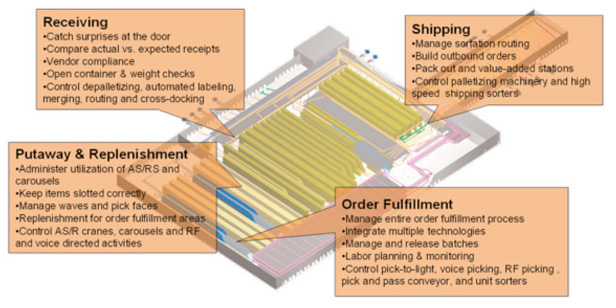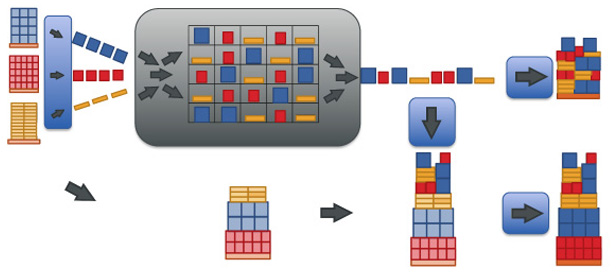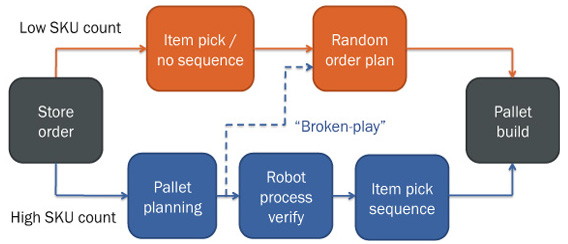Larry Sweet of Symbotic and Chris Ray of Hartness International presented their work in robotic applications of material handling in distribution centers at the recent RoboBusiness Leadership Summit covering the historical applications, the market drivers that are challenging these approaches and the emerging software and mobile robotic technologies that are attempting to solve these problems.
Warehouse Process Flow
Material handling robots have been used for decades in manufacturing plants for palletizing and similar tasks, handling a limited range of SKU’s. However, this technology was ineffective downstream in the supply chain at distribution centers, where vastly greater complexity in product diversity, dimensions, and packaging must be accommodated.

Emerging Technology Trends
Market drivers such as increased labor and fuel costs have encouraged innovation, with new technologies enabling an emerging market for fully automated warehouses capable of fulfilling highly mixed SKU orders. The most important new technologies are in three areas.
- Advanced Software – divides each customer order into discrete pallets, each being a complex 3D “puzzle” subject to various stacking rules, and selected from inventories of more than 10,000 SKU’s. Complementary software then generates unique robot motion programs to build the pallets.
- Mobile Robots (Rovers) – and other innovative technologies are addressing the need to pick individual SKU’s from a storage structure and deliver the outbound items in a defined, specific sequence in order to build the pallets robotically. These new approaches overcome the rate limitations of traditional crane-based mini-load ASRS.
- Technological Scalability – these systems are scalable to unprecedented levels, with many hundreds of rovers delivering many thousands of cases per hour.
Methods of Simplification
The applications of these technologies ultimately drive a more simplified fulfillment process flow at every stage – from receiving through a storage and retrieval system to order fulfillment. Ultimately, the management and flow of cases for a built-to-order unit load and ship includes:
- Replenishment: receiving incoming homogenous pallets from manufacturers
- Palletizing: de-layering or depalletizing to direct order fulfillment or singulated for storage or directly to mixed-item palletizing
- Rover Storage, Order Picking & Sequencing: retrieval or picking from storage using optimal sequencing
Simplified Warehouse Process Overview

Challenges
Robotic integrators have struggled with reliably handling thousands of packing styles and tens of thousands of product SKUs. Where this is most evident is in mixed case palletizing – specifically with the sequencing of product with automation and maintain high throughput. Rovers (mobile robots) need to deliver the cases from the storage system in the right order for maintain high packing density and to build the pallet to meet store and/or truck requirements.
Algorithmic Software Method for Sequencing
Software is used to manage the differences between what the store ultimately wants delivered and the reality of the case characteristics. The software has to track a multitude of characteristics of cases including variable dimensions, packaging types, weights, SKUs and store aisle locations using sophisticated algorithms to build these friendly and stable pallets.
Mixed case palletizing software

Article topics
Email Sign Up

















